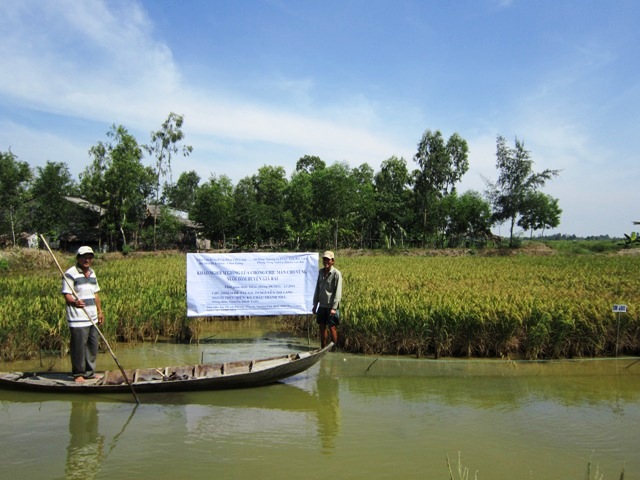Vietnam can prepare for salinity and drought, experts say

| Farmers in the Mekong Delta need all the information and support that they can get to overcome the challenge of severe drought and salinity. IRRI photo |
The rice fields of Vietnamese farmers in the Mekong River Delta (MRD) and other coastal areas have recently been undergoing acute drought and salt water intrusion. However, according to scientists at the International Rice Research Institute (IRRI), these problems can be foreseen and viable options are being made available to help farmers cope and avoid production and income losses.
Presiding at a recent workshop, Cao Duc Phat, Vietnam’s Minister of Agriculture and Rural Development (MARD), expressed deep concern about these ongoing disasters, hence, the discussion on possible solutions and resources in the short- and long-term. Across the country, hundreds of hectares of rice paddies have already been affected by salinity and drought.
Salinity is driven mainly by lack of rainfall. The El Niño phenomenon worsens the condition.
In 1998 and 2010, severe salinity intrusion occurred in Vietnam. Each of these intrusions took place one year after an El Niño event. Since 1965, the second most severe El Niño, worldwide, occurred in 2015.
“To some extent, high salinity intrusion in the MRD can be predicted," said To Phuc Tuong, IRRI water management engineer. "So, this allows for proper planning for adapting to the situation.”
Observations during the recently concluded IRRI project, Climate Change Affecting Land Use in the Mekong Delta: Adaptation of Rice-based Cropping Systems (CLUES), point more to decreasing upstream flows as a significant cause of increased salinity and not much due to sea-level rise.
“Within the next 30 years, 40% of the MRD will be affected by salt intrusion,” said Ngo Dang Phong, CLUES’ project facilitator.
High salinity causes rice “burnt-out” or white leaf tip followed by tip burning and chaffy panicles, which leads to significant yield reduction.
Building on previous studies with local partners, IRRI has various recommendations to combat both salinity and drought.
In the CLUES project, new breeding lines that are salt- and submergence-tolerant were developed and tested for their suitability in the MRD.
“In high-risk areas for salinity, the development and delivery of short-duration, good quality rice with enhanced salt tolerance should be fast-tracked,” said Tuong.
For decades, Vietnamese farmers have been intensively planting three crops per year. However, to avoid salinity, it may be more appropriate to plant two long-duration rice crops annually rather than grow three short-duration crops.
During periods of drought, alternate wetting and drying (AWD) and other water management practices can be adopted along with the use of suitable varieties. Because AWD involves flooding and re-flooding of paddy fields at specific time periods, this reduces the risk of using saline irrigation water.
|
Leocadio Sebastian, IRRI's country representative to Vietnam and regional program leader of the
CGIAR Research Program on Climate Change, Agriculture and Food Security, shares insights and recommendations from IRRI scientists during the workshop. (VTV1 screenshot) |
“Currently, IRRI and Can Tho University are implementing a salinity advisory as part of the Location-specific Timely Service (SALTS) subproject for rice farmers that is part of a BMZ Small Grant Project. “Using information and communication technology (ICT), SALTS aims to provide real-time, location-specific salinity monitoring and advisories, including rainfall forecasts,” said Paolo Ficarelli, IRRI ICT expert.
Leocadio Sebastian, IRRI’s country representative to Vietnam and regional program leader of the CGIAR Research Program on Climate Change, Agriculture, and Food Security (CCAFS), added that the climate-smart agriculture approach should be considered in the country’s medium- and long-term plans for climate change adaptation and mitigation.
Vietnam has been a global leader in rice production and IRRI has been working closely with the government to improve continuously its rice sector and make it more sustainable and climate change-resilient. In relation to this, the institute has extended some technical assistance to the development of Vietnam’s Rice Restructuring Strategy, which explicitly states collaboration in developing rice varieties with high export value, adopting advanced crop management techniques, and more intensive use of machines and other technologies in rice farming.
Related links:
IRRI statement on current salinity and drought problems affecting rice areas in Vietnam
TV coverage in Vietnamese (at 30:17)
Scientists help Vietnam’s rice farmers adapt to climate change, amid major drought
Development partners suggest drought response measures; Hạn hán khiến nhiều hồ nước trong tỉnh Ninh Thuận cạn khô (Vietnamese version)
